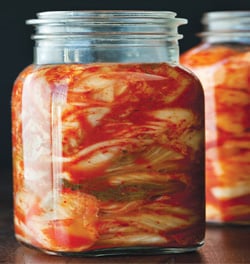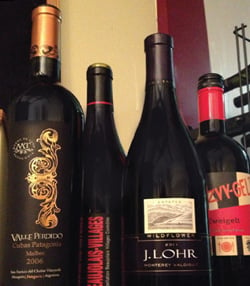At Anne Saxelby’s all-American cheese store in NYC’s Essex Market, she offers a grilled cheese layered with kimchi. At Court Street Grocers in Brooklyn, kimchi gives a kick to a brisket sandwich. The Kimchi Taco Truck has nearly 8,000 people following its whereabouts on Twitter, hoping to score a “Kim-Cheesesteak” with a side of kimchi-spiked arancini. No longer the condiment acculturated Koreans feel they have to hide in the depths of the refrigerator, kimchi has made it onto the American table.
Even so, wine, particularly red wine, isn’t an obvious match for kimchi. It’s most commonly made from cabbage, a sulfurous vegetable that may have an easier time in the company of white wine or beer, and it’s fermented, usually with spicy red pepper.
So when Lauryn Chun, a former tasting coordinator at W&S, now the head of Mother-In-Law’s Kimchi, asked me to help her conduct a wine-and-kimchi tasting for the launch of her Kimchi Cookbook (Ten Speed Press; $20), I balked. Then I began collecting wine.
Keeping in mind that tannins and alcohol exacerbate pepper heat, I skewed toward light whites. I found a little sweetness went far in curbing the heat, and sparklers proved their reputation as the ninjas of wines, able to handle just about anything.
But the most fascinating combination involved a red wine—a Beaujolais Nouveau—that was light, low in alcohol and tannins. But the pairing was the most dynamic of any we’d tried, the red fruit of the wine picking up the fruit of the red pepper, its juiciness quashing any chile fire.
As Chun pointed out, “Kimchi is naturally fermented—like wine, and the acidity is less aggressive than in a pickle. Also like wine, it’s alive, changing as it ages, mellowing in its bite. A good kimchi might even bubble, a little like Champagne.” And she added that the chiles traditional in Korea aren’t nearly as hot as your average jalapeño; they have a noticeably fruity flavor, in fact.
So we gathered more kimchi, another group of wines—all red—and a panel of serious tasters: Eduardo Porto Carreiro from Boulud Sud, Kyungmoon Kim of NYC’s Jungsik, Peter Liem of champagneguide.net, Carla Rzeszewski from The Breslin and Bernie Sun of Jean-Georges Restaurant Group, plus W&S tasting director Carson Demmond and editor Joshua Greene.


As we tasted through the wines and the kimchi, the excitement around the table was clear in our Twitter feed; here are some of the highlights.
Delicacy
J. Lohr 2011 Monterey Wildflower Valdiguié
Valdiguié—a grape from Southern France that was mistaken for gamay in California vineyards for decades—makes a light, juicy wine with lots of delicate floral and herbal nuances. Tasting through a number of wines, we quickly established that any low-alcohol, low-tannin red was going to be a good bet with the spice of kimchi, but the valdiguié went a step further, its light layers of flavor highlighting the many dimensions of the kimchi, from vegetal to spicy and fruity.
Transparency isn’t everything, though: An array of pinot noirs showed disastrously. A lean, willowy Hippolyte Reverdy Sancerre felt mean and angular with the kimchi; a richer Finger Lakes bottling went vegetal and funky. “It’s the juicy clarity of the fruit,” said Carson Demmond of the valdiguié. “It feels cooling.”
Fruit
Christophe Pacalet 2011 Beaujolais-Villages
“This is the one wine that holds its own with all of [the kimchis],” said Carla Rzeszewski of The Breslin. “It’s so juicy it feels like a reprieve.” Porto Carreiro agreed: “There’s a cool give-and-take here. It’s like a really good surfer catching a wave: The kimchi rides on the crest of the wine, and the elegance of the wine isn’t lost.” Demmond commented that the gamey note in the Pacalet plays up the umami of the kimchi. “Koreans would think this is bizarre,” said Kim, “but it reminds me of Korean barbecue with pork belly and kimchi.” Wine as meat; kimchi as garnish.


Meinhard Forstreiter 2009 Austria Zvy-gelt
Monika Caha, a former chef turned Austrian wine importer, suggested zweigelt might make a kimchi-friendly pairing when we’d met her at Chun’s book launch. This bottling is in the juicy, simple mode, but has a little age. The combination worked terrifically with the kimchi, the mature notes drawing out the umami characteristics of the kimchi, and in the process throwing the fruit into bright relief. Bernie Sun of Jean-Georges gave this his top ranking in his personal three-tier system, which goes something like this: 1.) doesn’t work, 2.) zero–sum game, in which both wine and food stay the same, or 3.) dynamic—like this combination, in which both kimchi and wine tasted more complex together than they did apart.
Spice
E. Guigal 2010 Châteauneuf-du-Pape
We included this wine based on a comment on Eater by Yoon Ha, the wine director of Benu in San Francisco, who said he finds that Châteauneuf-du-Pape has a particular affinity for chef Corey Lee’s Asian-accented cuisine. In the case of the Guigal, it’s as if the spice of the wine makes room for the spice of the kimchi, the two blending into a complex tapestry of flavor. “There’s real interaction between the kimchi and the wine,” said Josh Greene, “a lot of interplay of flavors.” While some found the combination a little hot, Kim reminded us that you’d rarely eat kimchi without a side of rice. He often opts for Rhône wines, in fact, with Jungsik’s kimchi-sauced Waygu steak. “I used to go with Cornas,” he said, “but now I’ve changed to St-Joseph: all that black pepper and spice [flavor] translates well with the kimchi spice.”
Contrast
Valle Perdido 2006 Patagonia Cubas Patagonia Malbec
This was a surprising combination: a crisp, very delicate, almost sweet white kimchi entirely free of red pepper, and a rich, deeply cherry-flavored malbec with mature notes of tobacco and earth and velvety tannins. “We serve a white truffle risotto with a bit of this white kimchi chopped up on top,” said Kim, explaining why he even tried the combination. “I usually go with a white, or an Amontillado Sherry, but after this, I think I’m going to rethink that.” It was as if the malbec’s lush fruit provided a velvet pillow to show off all the facets of the kimchi, from the crispness of its texture to its bright, gingery highlight. And, Chun added, “The white kimchi seems to freshen the malbec and bring out the acidity that was hidden.”
This story was featured in W&S February 2013.
photos by Sara Remington; photos reprinted with permission from The Kimchi Cookbook: 60 Traditional and Modern Ways to Make and Eat Kimchi, by Lauryn Chun, copyright 2012. Published by Ten Speed Press, a division of Random House, Inc.
is W&S’s editor at large and covers the wines of the Mediterranean and Central and Eastern Europe for the magazine.
This story appears in the print issue of February 2013.
Like what you read? Subscribe today.
















